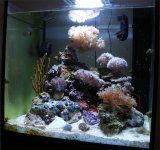Alright. Bad news....
All the xenia circled in red has been eaten in the past seven days.
Good (sort of) news...
I'm now pretty sure the problem is a eunicid worm. Based on the amount of xenia that goes missing at a time and the gash marks left behind, if it is a worm eating it I'd have to guess it to be between 1/4" and 3/8" wide, which on a eunicid would imply a body length of around 8". At that size most eunicids are primarily detrivores... but even at that size, they have a taste for xenia and will eat it preferentially.
I never find any tracks in the sand near the affected colonies; a eunicid wouldn't leave any, since they extend their bodies from holes in the rockwork.
I never see the culprit; eunicid's only come out at night and are shy even then. The slightest movement or vibration and they retract completely into their holes almost instantly.
Nothing gets touched other than xenia; larger eunicids will happily eat just about anything in a reef tank, but even then they prefer soft corals. Smaller ones however are predominantly harmless, aside from their xenia chomping.
The xenia that's left behind when some is taken has ragged edges, more consistant with having been the subject of many bites than of being cut repeatedly with sharp claws. Eunicids have five sets of jaws and powerful bites.
The xenia that's taken is dragged away. This is definitely consistant with a eunicid, who would bring it's food back with it to it's hole when it withdraws.
It's all circumstantial evidence, but it fits. The downside is that eunicids are the devil to remove. Since they never completely leave their holes when foraging, conventional worm type traps don't work. Nor would a piano key door trap. Spotting one is difficult, attempting to grab one with forceps if you actually do see it is almost impossible due to how quickly they withdraw into their holes, and worse, their bodies are designed to break off if grabbed with both segments growing back into healthy worms.
I'm going to make an assumption that the eunicid lives in the same rock as his food source. It's got plenty of holes and cavities, and it makes sense for it to live close to it's meals. I'm going to remove what's left of the xenia elongata from that rock, then remove that rock from the tank. Not guaranteed I'll get the worm that way, but it's worth a shot as a first step.







